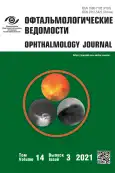Neurotrophic keratopathy and Wallenberg – Zakharchenko syndrome: a clinical case
- 作者: Ezugbaya M.B.1, Astakhov S.Y.1, Riks I.A.1, Papanyan S.S.1, Boutaba R.1, Mikhalchenko Y.G.2, Yakushenko A.R.1
-
隶属关系:
- Academician I.P. Pavlov First St. Petersburg State Medical University
- Clinic “Scandinavia”, LLC “AVA-PETER”
- 期: 卷 14, 编号 3 (2021)
- 页面: 83-90
- 栏目: Case reports
- URL: https://journals.rcsi.science/ov/article/view/79199
- DOI: https://doi.org/10.17816/OV79199
- ID: 79199
如何引用文章
详细
BACKGROUND: Degenerative changes of cornea after transection of the trigeminal nerve were first described by F. Magendie in 1824. Neurotrophic keratopathy is considered to be an orphan disease which lately has been recognized more and more often. According to literature data, neurotropchic keratopathy affects 5 individuals in 10,000. The diagnosis is difficult due to the lack of information about this condition, the rare occurrence and the presence of a large number of etiological factors.
AIM: To determine the causes of the neurotrophic keratopathy development and the treatment tactics in a patient with a neurological disease. The article presents a case of neurotrophic keratopathy in a patient with Wallenberg – Zakharchenko syndrome.
Because of the fact that neurotrophic keratopathy was diagnosed late and the correct treatment did not start in time, further progression of the pathological process in the cornea could not be avoided. Periodic recurrence of neurotrophic keratopathy is associated with an underlying chronic neurological disease.
CONCLUSIONS: Neurotrophic keratopathy requires early diagnosis. In certain clinical cases, for the successful treatment of this pathology, it is necessary to prescribe systemic therapy.
作者简介
Maggie Ezugbaya
Academician I.P. Pavlov First St. Petersburg State Medical University
编辑信件的主要联系方式.
Email: maggie-92@mail.ru
ORCID iD: 0000-0002-0421-1804
МD,Postgraduate Research student, Ophthalmology Department
俄罗斯联邦, 6–8, L’va Tolstogo str., Saint Petersburg, 197022Sergey Astakhov
Academician I.P. Pavlov First St. Petersburg State Medical University
Email: astakhov73@mail.ru
ORCID iD: 0000-0003-0777-4861
SPIN 代码: 7732-1150
МD,PhD, DMedSc, Professor, head of the department, Ophthalmology Department
俄罗斯联邦, 6–8, L’va Tolstogo str., Saint Petersburg, 197022Inna Riks
Academician I.P. Pavlov First St. Petersburg State Medical University
Email: riks0503@yandex.ru
ORCID iD: 0000-0002-5187-1047
SPIN 代码: 4297-6543
МD, PhD, Assistant, Ophthalmology Department
俄罗斯联邦, 6–8, L’va Tolstogo str., Saint Petersburg, 197022Sanasar Papanyan
Academician I.P. Pavlov First St. Petersburg State Medical University
Email: Dr.papanyan@yandex.ru
ORCID iD: 0000-0003-3766-2211
SPIN 代码: 9794-4692
МD, PhD, Ophtalmologist, Ophthalmology Department
俄罗斯联邦, 6–8, L’va Tolstogo str., Saint Petersburg, 197022Rafik Boutaba
Academician I.P. Pavlov First St. Petersburg State Medical University
Email: boutabarafik@yahoo.fr
ORCID iD: 0000-0002-3700-8255
МD, Clinical Resident, Ophthalmology Department
俄罗斯联邦, 6–8, L’va Tolstogo str., Saint Petersburg, 197022Yuliya Mikhalchenko
Clinic “Scandinavia”, LLC “AVA-PETER”
Email: erisod29@mail.ru
ophthalmologist
俄罗斯联邦, Saint PetersburgAlexey Yakushenko
Academician I.P. Pavlov First St. Petersburg State Medical University
Email: yakushenkoalex@yandex.ru
student
俄罗斯联邦, 6–8, L’va Tolstogo str., Saint Petersburg, 197022参考
- Magendie F. The influence of the fifth pair of nerves on nutrition and function of the eye. J Physiol Exp Pathol. 1824;4:176–182. (In French.)
- Dua HS, Said DG, Messmer EM, et al. Neuropathic Keratopathy. [Internet] Progress in Retinal and Eye Research, 2018. Available from: https://research.birmingham.ac.uk/portal/en/publications/neurotrophic-keratopathy(2478a374-6546-4972-a335-54590310c27c).html. doi: 10.1016/j.preteyeres.2018.04.003
- Bonini S, Rama P, Olzi D, Lambiase A. Neurotrophic keratitis. Eye (Lond). 2003;17:989–995. doi: 10.1038/sj.eye.6700616
- Morishige N, Morita Y, Yamada N, et al. Congenital hypoplastic trigeminal nerve revealed by manifestation of corneal disorders likely caused by neural factor deficiency. Case reports in ophthalmology. 2014;5(2):181–185. doi: 10.1159/000364899
- Lin X, Xu B, Sun Y, et al. Comparison of deep anterior lamellar keratoplasty and penetrating keratoplasty with respect to postoperative corneal sensitivity and tear film function. Graefe’s archive for clinical and experimental ophthalmology. 2014;252:1779–1787. doi: 10.1007/s00417-014-2748-6
- Wilson SE, Ambrosio R. Laser in situ keratomileusis-induced neurotrophic epitheliopathy. Am J Ophthalmol. 2001;132(3):405–406. doi: 10.1016/s0002-9394(01)00995-3
- Wilson SE, Ambrosio R. Laser in situ keratomileusis-induced neurotrophic epitheliopathy. Am J Ophthalmol. 2001;132(3):405–406. doi: 10.1016/s0002-9394(01)00995-3
- Lockwood A, Hope-Ross M, Chell P. Neurotrophic keratopathy and diabetes mellitus. Eye (Lond). 2006;20:837–839. doi: 10.1038/sj.eye.6702053
- Semeraro F, Forbice E, Romano V, et al. Neurotrophic keratitis. Ophthalmologica. 2014;231:191–197. doi: 10.1159/000354380
- Hsu HY, Modi D. Etiologies, Quantitative Hypoesthesia, and Clinical Outcomes of Neurotrophic Keratopathy. Eye Contact Lens. 2015;41(5):314–317. doi: 10.1097/ICL.0000000000000133
- Mackie IA. Neuroparalytic keratitis. In: Fraunfelder FT, Roy FH, Grove J, editors. Current Ocular Therapy, 4 ed. WB Saunders. Philadelphia, 1995. P. 452–454.
- Riks IA, Papanyan SS, Astakhov SYu, Novikov SA. Novel clinico-morphological classification of the corneal endothelial-epithelial dystrophy. Ophthalmology journal. 2017;10(3):46–52. (In Russ.) doi: 10.17816/OV10346-52
- Astakhov SYu, Novikov SA, Papanyan SS, Riks IA. Еvaluate the Effectiveness of Accelerated Collagen Crosslinking in the Treatment of Corneal Endothelial Decompensation. Ophthalmology in Russia. 2020;17(4): 699–704. (In Russ.) doi: 10.18008/1816-5095-2020-4-699-704
- Mastropasqua L, Nubile M, Lanzini M, et al. In vivo microscopic and optical coherence tomography classification of neurotrophic keratopathy. J Cell Physiol. 2019;234(5):6108–6115. doi: 10.1002/jcp.27345
- Kugadas A, Gadjeva M. Impact of Microbiome on Ocular Health. Ocul Surf. 2016;14(3):342–349. doi: 10.1016/j.jtos.2016.04.004
- Ayaki M, Iwasawa A, Niwano Y. In vitro assessment of the cytotoxicity of six topical antibiotics to four cultured ocular surface cell lines. Biocontrol Sci. 2012;17(2):93–99. doi: 10.4265/bio.17.93
- Bonini S, Lambiase A, Rama P, et al. Topical treatment with nerve growth factor for neurotrophic keratitis. Ophthalmology. 2000;107(7):1347–1351. doi: 10.1016/s0161-6420(00)00163-9
- Yamada N, Matsuda R, Morishige N, et al. Open clinical study of eye-drops containing tetrapeptides derived from substance P and insulin-like growth factor-1 for treatment of persistent corneal epithelial defects associated with neurotrophic keratopathy. Br J Ophthalmol. 2008;92(7):896–900. doi: 10.1136/bjo.2007.130013
- Guerra M, Marques S, Gil JQ, et al. Neurotrophic Keratopathy: Therapeutic Approach Using a Novel Matrix Regenerating Agent. J Ocul Pharmacol Ther. 2017;33(9):662–669. doi: 10.1089/jop.2017.0010
- Trufanov SV. Cyanoacrylate adhesive in surgical treatment of corneal perforation (clinical case). The Russian annals of ophthalmology. 2020;136(5–2):232–236. (In Russ.) doi: 10.17116/oftalma2020136052232
补充文件












